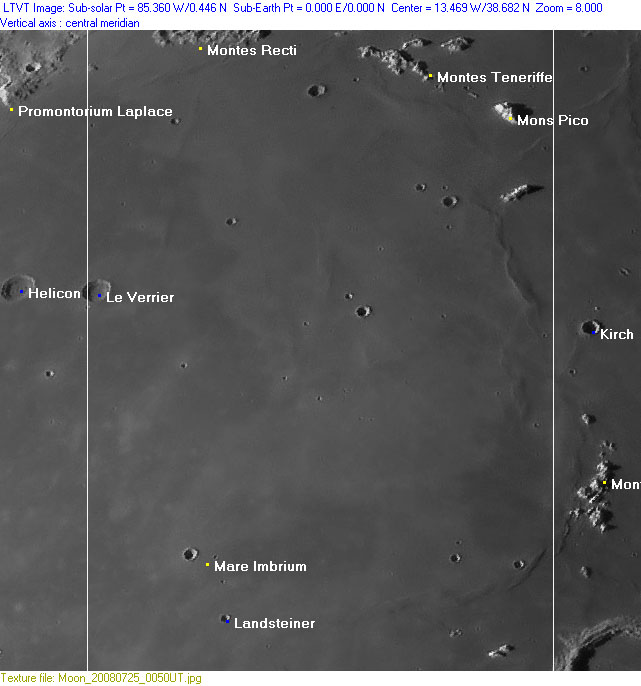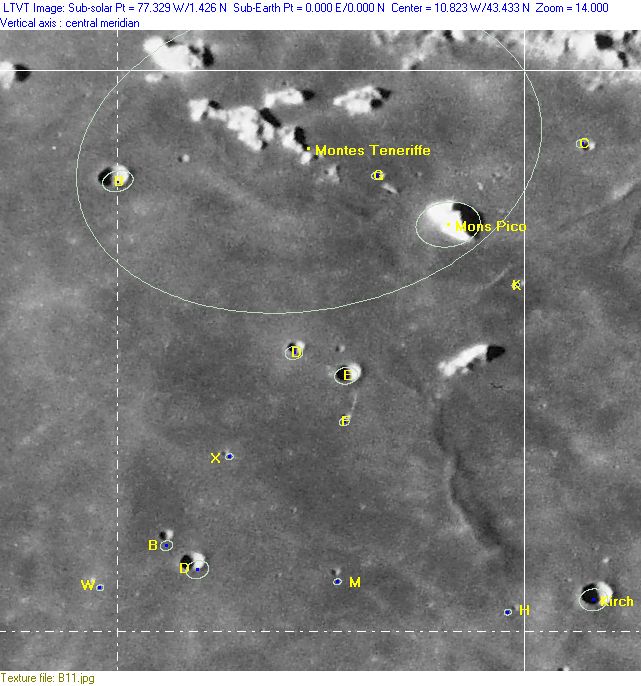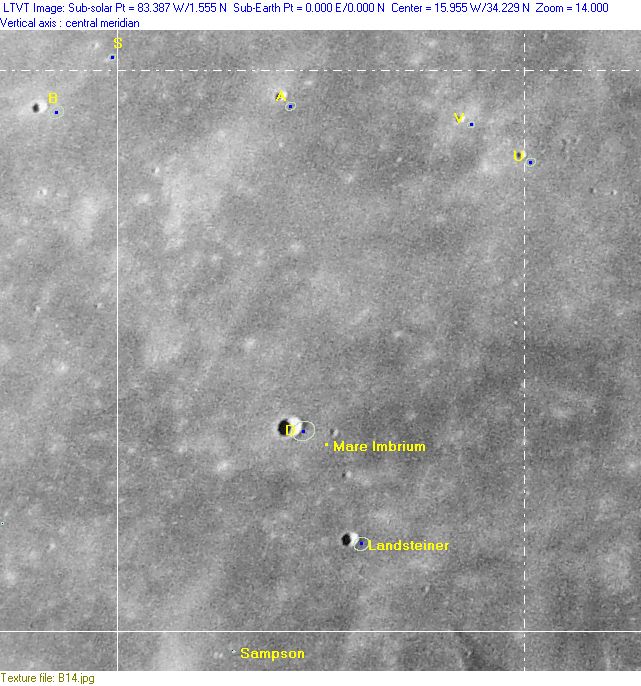Rükl 11
Contents
Rükl Zone 11 - LE VERRIER
Neighboring maps on the Rükl Nearside Map:
Table of Contents
[#Rükl Zone 11 - LE VERRIER Rükl Zone 11 - LE VERRIER]
[#Rükl Zone 11 - LE VERRIER-Photographic Map Photographic Map]
[#Rükl Zone 11 - LE VERRIER-Named Features Named Features]
[#Rükl Zone 11 - LE VERRIER-Chang'e 3 landingsite Chang'e 3 landingsite]
[#Rükl Zone 11 - LE VERRIER-Lettered Crater Locations Lettered Crater Locations]
[#Rükl Zone 11 - LE VERRIER-Additional Information Additional Information]
[#Rükl Zone 11 - LE VERRIER-Montes Teneriffe and its individual peaks, named by J.Lee and W.R.Birt Montes Teneriffe and its individual peaks, named by J.Lee and W.R.Birt]
| 11 |
||
Photographic Map
(This map is based on an Earth-based photograph that has been computer-corrected to zero libration. The vertical white lines indicate the left and right boundaries of the Rükl rectangle)
Background image source
Named Features
- Ancient Newton (informal name, sometimes erroneously called Bliss).
- Archimedes Zeta (the couple of hillocks west-northwest of Archimedes, depicted near the lower right corner of Chart 11).
- Archimedis (Van Langren's disallowed name for the hill Montes Teneriffe Iota).
- Boat (a nickname from M.Collins for a very odd formation west of Montes Recti, see LPOD A Boat upon the Sea, 16-8-2012).
- Catena Le Verrier (an unofficial name from D.Caes for the rectilinear chain of impact craterlets east-southeast of Le Verrier, another such chain is located further eastward).
- Catena Pico (an unofficial name from D.Caes for the officially unnamed chain of craterlets near Mons Pico, once described by A.Herring in Sky & Telescope).
- Chang'e 3 and Yutu (Chang'e 3 soft-landed on December 14, 2013, south of Laplace F, very near Laplace FA).
- Coci (Van Langren's disallowed name for the hill Montes Teneriffe Delta, see also J.Hewelcke's Insula Ophiusa).
- D'Auxoni (Van Langren's disallowed name for Montes Recti Beta).
- De Bergerac (a disallowed name from H.P.Wilkins for the distinct bowl shaped crater Carlini D, north-northwest of Landsteiner).
- Dorsa Recti (an unofficial name from D.Caes for the system of wrinkle ridges immediately south of Montes Recti).
- Dorsum Grabau (southeast of Landsteiner).
- Dorsum Haas (an unofficial name from D.Caes for the wrinkle ridge south-southeast of Pico E, aka Haas).
- Dorsum Laplace F (an unofficial name from D.Caes for the wrinkle ridge east of the bowl-shaped crater Laplace F, south of Montes Recti) (seems to be the northern continuation of Dorsum Le Verrier).
- Dorsum Le Verrier (an unofficial name from D.Caes for the wrinkle ridge northeast of Le Verrier) (seems to be the southern continuation of Dorsum Laplace F).
- Dorsum Pico K (an unofficial name from D.Caes for the short wrinkle ridge between the bowl-shaped crater Pico K and Mons Pico).
- Dorsum Spitzbergen (an unofficial name from D.Caes for the wrinkle ridge southwest of Montes Spitzbergen).
- Dorsum Teneriffe (an unofficial name from D.Caes for the wrinkle ridge south of Montes Teneriffe).
- Dupont (a disallowed name from F.C.Lamech for Pico E, which was also called Haas by H.P.Wilkins).
- Haas (a disallowed name from H.P.Wilkins for Pico E, the largest one of the couple of bowl shaped craters southwest of Mons Pico and west of Pico Beta) (Pico E was called Dupont by F.C.Lamech).
- Insula Capraria (J.Hewelcke's disallowed name for the hill Montes Teneriffe Epsilon, see also Van Langren's Lini).
- Insula Ophiusa (J.Hewelcke's disallowed name for the hill Montes Teneriffe Delta, see also Van Langren's Coci).
- Insulae Calabraria (J.Hewelcke's disallowed name for certain hills of which their locations could be somewhere in Montes Teneriffe).
- Lacus Marinus (J.Hewelcke's disallowed name for the region west of the IAU's Archimedes).
- Landsteiner
- Laplace F's shallow crater (west of Laplace F) (not really a name, but... it's better than nothing...) (see also LROC article Ghost crater in Mare Imbrium).
- Le Verrier (J.Hewelcke's Insula Erroris).
- Lini (Van Langren's disallowed name for the hill Montes Teneriffe Epsilon, see also J.Hewelcke's Insula Capraria).
- Mare Imbrium (Van Langren's Mare Austriacum, J.Hewelcke's Mare Mediterraneum).
- Mons Laplace (a name from D.Caes for the officially unnamed hill east-northeast of Promontorium Laplace, about halfway between Promontorium Laplace and Montes Recti) (note: there seems to be no Greek letter designation for this hillock, nor for the cluster of hillocks west of Promontorium Laplace, see Chart 10, and also Chart 8 in the Times Atlas of the Moon...).
- Mons Pico (Van Langren's Cobavi, J.Hewelcke's Insula Minorca).
- Pico Beta (the elongated hillock south of Mons Pico, once called Pitati by Van Langren and Insula Ebissus by Hevelius).
- Montes Recti (J.Hewelcke's Insula Majorca).
- Montes Teneriffe (and its individual peaks, once named by J.Lee and W.R.Birt, see Additional Information below).
- Reese (a disallowed name from H.P.Wilkins for the distinct crater Pico B, southwest of Montes Teneriffe).
- Schotenii (Van Langren's disallowed name for Montes Recti Epsilon) (?) (E.A.Whitaker seems to be uncertain about that one).
Chang'e 3 landingsite
Lettered Crater Locations
(click on the thumbnails to display full-sized images; use browser BACK button to return - the dashed white lines are the midpoints of the Rükl zones)
Full zone with lettered craters:

Lettered craters by quadrants:
| North West |
North East |
| South West |
South East |
Additional Information
- Other online descriptions of features in this Rükl map section:
Montes Teneriffe and its individual peaks, named by J.Lee and W.R.Birt
John Lee (1864) suggested naming the individual peaks of Montes Teneriffe (note the change, not corrected for in the quote, in lunar directions since this was written):
"These mountains are each designated by a Teneriffian appellation. A fine rock, equal to "Pico," and westward of "Piazzi Smyth," is called "Piton"; those south and north of "Pico," "Guajara" and "Rambleta"; a fine branching chain east of "Rambleta," "Alta Vista"; and a rock N.E. of "Rambleta," "Chajorra." "
William Radcliff Birt (1864) gives the name Petora, but omits Piton. Since Piazzi Smyth is explained there as "a small crater near Kirch, it is between Petora and Guajara" it sounds like Birt is using Petora as an alternative spelling for Lee's Piton.
Note: Piton, Alta Vista, Chajorra, Guajara, and Rambleta all figure prominently in Piazzi Smyth's book. There does not appear to be any mention of Petora or the earlier name Pico, however in his book Johann Schröter repeatedly compares his Pico to the "Pico aus Tenerifa," so it is presumably a reference to what Piazzi Smyth calls "the Peak of Teneriffe" (the modern Teide?).
Research: Jim Mosher.
This page has been edited 1 times. The last modification was made by - tychocrater tychocrater on Jun 13, 2009 3:24 pm - mgx2




